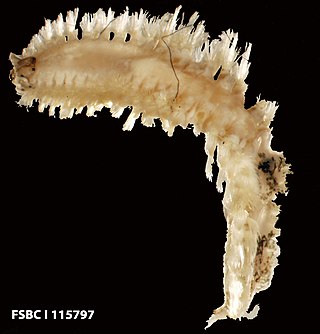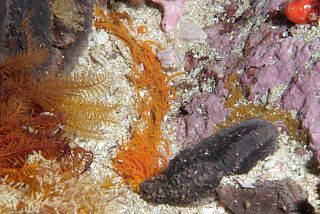
The Terebellidae is a marine family of polychaete worms, of which the type taxon is Terebella, described by Carl Linnaeus in his 1767 12th edition of Systema Naturae.

Nephtys is a genus of marine catworms. Some species are halotolerant to a degree in that they can survive in estuaries and estuarine lagoons down to a salinity of 20 psu.

Harmothoe is a genus of marine Polychaete worms belonging to the family Polynoidae. Species of Harmothoe are found world-wide to depths of at least 5,000 m but are more common in shallower water.

Eunice is a genus in the polychaete family Eunicidae. Individuals grow to a length of between 0.5 and 300 cm. Their bodies have multiple segments. They have two eyes and five tentacles. They have well-developed sense organs and relatively large brains. Their color is dark purple-brown to red-brown with a white ring at the fourth segment. They are found in oceans and seas around the world. They have an evertible proboscis with distinctive mouthparts, some of which comprise two rows of maxilliary plates in a radula-like fashion.

Acrocirridae is a family of polychaete worms. Acrocirrids are detritivores, catching falling particles with numerous long prostomial tentacles. There are eight known genera, and at least 21 described species and subspecies within the Acrocirridae. The acrocirrids are primarily benthic (seabed-dwelling) animals, but at least two genera appear to have evolved or adapted to a pelagic (free-swimming) habitat.

Phyllodoce is a genus of polychaete worms, which contains about 200 species. The prostomium bears eyes, two pairs of antennae and a pair of large retractile nuchal organs. The eversible proboscis is clearly divided into two parts.

Diopatra is a genus of polychaete worms in the family Onuphidae.

Cirriformia is a genus of marine polychaete worms in the family Cirratulidae.

Terebellides is a genus of polychaete worms in the family Trichobranchidae.

Eulalia is a genus of polychaete worms.

Syllidae, commonly known as the necklace worms, is a family of small to medium-sized polychaete worms. Syllids are distinguished from other polychaetes by the presence of a muscular region of the anterior digestive tract known as the proventricle.
Amphitrite is a genus of polychaetes belonging to the family Terebellidae. The genus has cosmopolitan distribution.
Sigalionidae is a family of polychaetes belonging to the order Phyllodocida.
Prosphaerosyllis is a genus of polychaetes belonging to the family Syllidae.

Odontosyllis is a genus of annelids belonging to the family Syllidae.
Scolelepis is a genus of annelids belonging to the family Spionidae.
Brada is a genus of polychaetes belonging to the family Flabelligeridae.
Armandia is a genus of polychaetes belonging to the family Opheliidae.

Eumida is a genus of polychaetes belonging to the family Phyllodocidae.
Lumbrineris is a genus of polychaetes belonging to the family Lumbrineridae.












